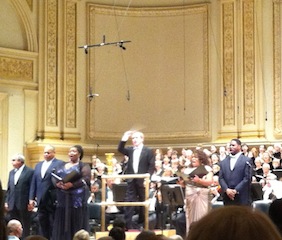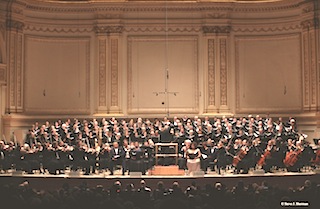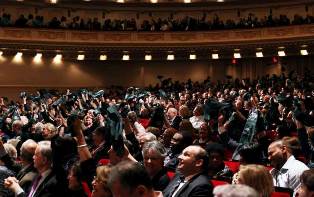
May Festival Tradition Captured Splendidly at Carnegie Hall

Hallelujah indeed.
The Cincinnati Symphony Orchestra and the May Festival Chorus sealed their triumph May 7 at Music Hall in Cincinnati with another one in New York’s Carnegie Hall May 9.
May Festival music director James Conlon -- awarded a cheering, standing ovation at the conclusion of R. Nathaniel Dett’s oratorio “The Ordering of Moses” -- responded as he did in Cincinnati with the “Hallelujah” Chorus from Handel’s “Messiah.”
The
concert before a packed hall was part of Carnegie Hall’s 2014 “Spring for
Music” Festival, and served as a fitting climax to “Cincy in New York,” a series
of events May 6-12 showcasing Cincinnati in New York. (For further information, visit http://www.cincyinnyc.com/index.php/events.) There were 835
Cincinnatians in the audience.

As he did at Music Hall, Conlon added a dramatic twist to the Dett, inserting two excerpts from the nationwide broadcast of its world premiere at the 1937 May Festival. He prefaced the performance with the NBC announcer’s introduction, then paused at the exact moment three-quarters of the way into the 55-minute work when it was taken off the air, in the announcer's words, “due to previous commitments” – commitments which have been ascribed to pressure from callers objecting to the airing of a work by an African-American composer. (The balance of the hour allocated for the 1937 broadcast was filled by organ music.)
Academically trained, with degrees from both the Oberlin Conservatory and the Eastman School of Music, Dett (1882-1943) set out to compose a work after the example of Antonin Dvorak, i.e. utilizing indigenous music. From the first motivic reference in the opening bars, the work is permeated by the spiritual “Go Down Moses.”
Scored for large orchestra, chorus and soloists, it falls into roughly eight parts, from the “calling of Moses” to lead the Israelites out of bondage in Egypt to the parting of the Red Sea and the drowning of the pursuing Egyptians. It is filled with drama and makes highly effective use of the voices. Soloists were soprano Latonia Moore as Miriam, mezzo-soprano Ronnita Nicole Miller as the Voice of Israel, tenor Rodrick Dixon as Moses and baritone Donnie Ray Albert as The Word/Voice of God. The 137-voice May Festival Chorus sang with deep feeling and precision, magnificently representing Cincinnati’s historic choral tradition.
Highlights were many: Miller’s plush mezzo early on as the voice of the suffering Israelites; the big choral climax on “Mercy, Lord!” just before God speaks to Moses from the burning bush; Dixon’s “Lord, who am I to go unto Pharaoh,” delivered in a ringing voice; Albert’s magisterial “Is it not I, Jehovah?” as God gives Moses his instructions and the chorus’ emphatic, idiomatic iterations of “Go Down Moses.”
A dramatic buildup took place on “And when Moses smote the water, the sea gave way,” followed by wordless chorus introduced by a “Bolero”-like snare drum as the Israelites passed through the Red Sea. Tambourine and castanet colored Moore’s exultant “Come let us praise Jehovah,” accompanied by choral ”Hallelujah’s.” It was at this point that the 1937 broadcast terminated.
The announcer’s crackly words made a sobering impression in the hall, followed immediately by what only Cincinnati heard 77 years ago, the final, jubilant “Sing Ye to Jehovah,” which came to an exuberant end,with thrilling high notes by Moore and Dixon.
A meltingly beautiful presence throughout the oratorio was CSO principal cellist Ilya Finkelshteyn, whose solos heightened the eloquence of both the words and the music.
The first half of the concert was devoted to John Adams’ 1981 "Harmonium" for chorus and orchestra. A setting of poems by John Donne and Emily Dickinson, it was completely at home in Carnegie Hall’s warm, defining acoustic. From a single, pulsing unison on “no, no,” Donne’s “Negative Love” built into rippling currents of harmony before coming to a quiet end. Dickinson’s “Because I Could Not Stop for Death” was slow moving and soft, conveying a feeling of quintessential mystery. The pace quickened as the music segued into Dickinson’s “Wild Nights,” which, beginning in the low brass and strings, moved excitedly through the chorus and orchestra to a big, orgiastic cutoff, followed by the words “Rowing in Eden,” whose lapping waves projected satiation.

Cincinnati fans waving scarves at Carnegie Hall, May 9, 2014 (photo by Steve J. Sherman)
|